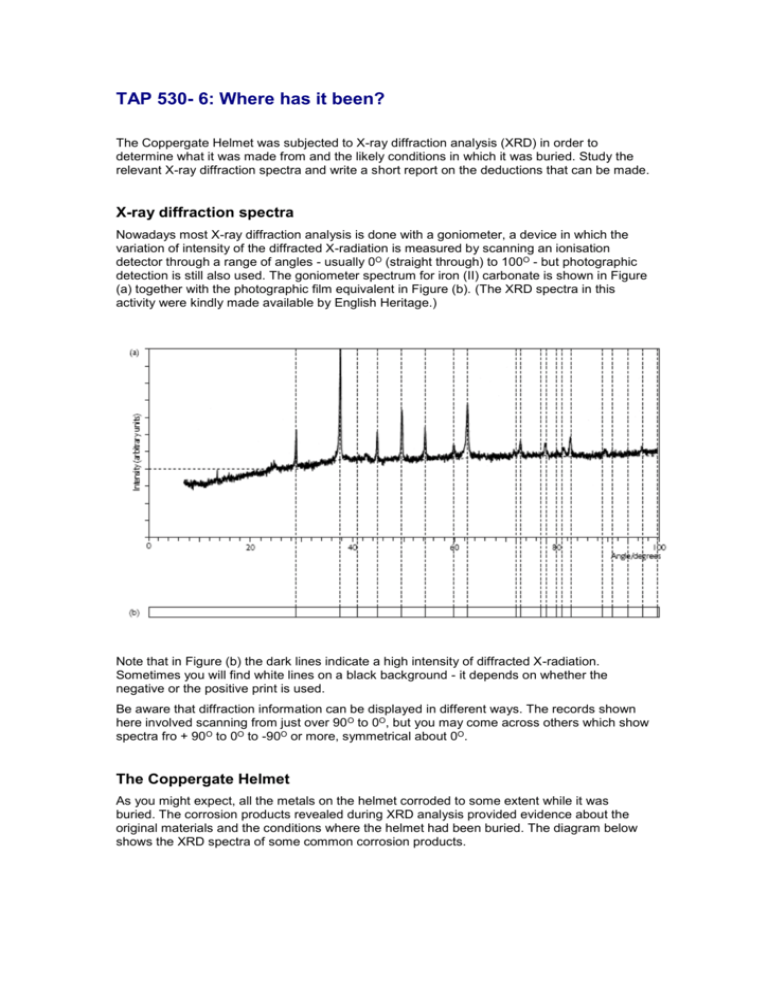TAP 350- 6: Where has it been
advertisement

TAP 530- 6: Where has it been? The Coppergate Helmet was subjected to X-ray diffraction analysis (XRD) in order to determine what it was made from and the likely conditions in which it was buried. Study the relevant X-ray diffraction spectra and write a short report on the deductions that can be made. X-ray diffraction spectra Nowadays most X-ray diffraction analysis is done with a goniometer, a device in which the variation of intensity of the diffracted X-radiation is measured by scanning an ionisation detector through a range of angles - usually 0O (straight through) to 100O - but photographic detection is still also used. The goniometer spectrum for iron (II) carbonate is shown in Figure (a) together with the photographic film equivalent in Figure (b). (The XRD spectra in this activity were kindly made available by English Heritage.) Note that in Figure (b) the dark lines indicate a high intensity of diffracted X-radiation. Sometimes you will find white lines on a black background - it depends on whether the negative or the positive print is used. Be aware that diffraction information can be displayed in different ways. The records shown here involved scanning from just over 90 O to 0O, but you may come across others which show spectra fro + 90O to 0O to -90O or more, symmetrical about 0O. The Coppergate Helmet As you might expect, all the metals on the helmet corroded to some extent while it was buried. The corrosion products revealed during XRD analysis provided evidence about the original materials and the conditions where the helmet had been buried. The diagram below shows the XRD spectra of some common corrosion products. Bornite (Cu5FeS4) This is a corrosion product of iron and copper alloy artefacts when buried on waterlogged sites. Chalcopyrite (CuFeS2) This is also a corrosion product of iron and copper alloy artefacts when buried on waterlogged sites. Siderite (FeCO3) This is a corrosion product of iron. It is found where there is, or has been at some time, a high concentration of carbonates in the water. Typical sources of these are plaster and mortar from earlier Roman buildings that have long since been demolished. Vivianite (Fe3 (PO4)2 8H2O) This is a corrosion product of iron which is found where the artefact has been buried alongside phosphates from bone and excreted waste. The XRD spectra in below are from two different parts of the Coppergate Helmet. Use the XRD spectra for corrosion products and the two spectra A and B above to report on what those parts of the helmet were made of, together with the conditions in which it had been buried. Practical advice Archaeologists examining the Coppergate Helmet used X-ray diffraction (XRD) to investigate the conditions in which it had been buried. They used XRD to examine the corrosion products in small samples of the helmet, and compared their spectra with those of corrosion products produced in known conditions. Students are provided with X-ray spectra from two samples of the helmet, and the spectra of four corrosion products together with information about the conditions that give rise to such products. Their task is to identify the corrosion products found in the helmet and hence to deduce the nature of the original materials and the conditions in which they had been buried. Answers X-ray diffraction spectrum A on the Activity Sheet shows that the corrosion sample is made up of siderite and vivianite. This indicates that the material that had corroded was made of iron. It also shows that, at some time, it was buried alongside organic phosphates probably produced from bone or excreted waste. In addition, the ground water around it had, at some time, a high concentration of carbonates, possibly as a result of demolition of earlier Roman buildings that had been built with plaster and mortar. XRD spectrum B shows that the corrosion sample is made up of bornite and chalcopyrite. This indicates that the material that had corroded was an iron and copper alloy, and had been buried in a waterlogged area. External reference This activity is taken from Salters Horners Advanced Physics, section DUTP, activity 18




